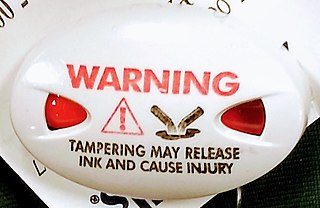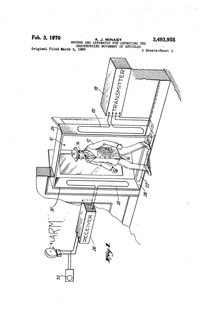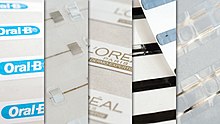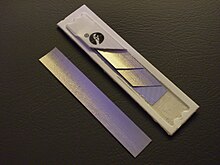
An inductor, also called a coil, choke, or reactor, is a passive two-terminal electrical component that stores energy in a magnetic field when electric current flows through it. An inductor typically consists of an insulated wire wound into a coil.

Electromagnetic compatibility (EMC) is the ability of electrical equipment and systems to function acceptably in their electromagnetic environment, by limiting the unintentional generation, propagation and reception of electromagnetic energy which may cause unwanted effects such as electromagnetic interference (EMI) or even physical damage to operational equipment. The goal of EMC is the correct operation of different equipment in a common electromagnetic environment. It is also the name given to the associated branch of electrical engineering.

Coaxial cable, or coax, is a type of electrical cable consisting of an inner conductor surrounded by a concentric conducting shield, with the two separated by a dielectric ; many coaxial cables also have a protective outer sheath or jacket. The term coaxial refers to the inner conductor and the outer shield sharing a geometric axis.

Radio waves are a type of electromagnetic radiation with the lowest frequencies and the longest wavelengths in the electromagnetic spectrum, typically with frequencies below 300 gigahertz (GHz) and wavelengths greater than 1 millimeter, about the diameter of a grain of rice. Like all electromagnetic waves, radio waves in a vacuum travel at the speed of light, and in the Earth's atmosphere at a slightly slower speed. Radio waves are generated by charged particles undergoing acceleration, such as time-varying electric currents. Naturally occurring radio waves are emitted by lightning and astronomical objects, and are part of the blackbody radiation emitted by all warm objects.

A Faraday cage or Faraday shield is an enclosure used to block electromagnetic fields. A Faraday shield may be formed by a continuous covering of conductive material, or in the case of a Faraday cage, by a mesh of such materials. Faraday cages are named after scientist Michael Faraday, who first constructed one in 1836.
Radio-frequency identification (RFID) uses electromagnetic fields to automatically identify and track tags attached to objects. An RFID system consists of a tiny radio transponder, a radio receiver and transmitter. When triggered by an electromagnetic interrogation pulse from a nearby RFID reader device, the tag transmits digital data, usually an identifying inventory number, back to the reader. This number can be used to track inventory goods.

Shoplifting, shop theft, retail theft, or retail fraud is the theft of goods from a retail establishment during business hours, typically by concealing a store item on one's person, in pockets, under clothes or in a bag, and leaving the store without paying. With clothing, shoplifters may put on items from the store and leave the store wearing the clothes. The terms shoplifting and shoplifter are not usually defined in law. The crime of shoplifting generally falls under the legal classification of larceny. Shoplifting is distinct from burglary, robbery, or armed robbery. In the retail industry, the word shrinkage can be used to refer to merchandise lost by shoplifting, but the word also includes loss by other means, such as waste, uninsured damage to products and theft by store employees.

In electrical engineering, electromagnetic shielding is the practice of reducing or redirecting the electromagnetic field (EMF) in a space with barriers made of conductive or magnetic materials. It is typically applied to enclosures, for isolating electrical devices from their surroundings, and to cables to isolate wires from the environment through which the cable runs. Electromagnetic shielding that blocks radio frequency (RF) electromagnetic radiation is also known as RF shielding.
Anti-theft systems protect valuables such as vehicles and personal property like wallets, phones, and jewelry. They are also used in retail settings to protect merchandise in the form of security tags and labels. Anti-theft systems include devices such as locks and keys, RFID tags, and GPS locators.

Retail loss prevention is a set of practices employed by retail companies to preserve profit. Loss prevention is mainly found within the retail sector but also can be found within other business environments.
In electronics, a ferrite core is a type of magnetic core made of ferrite on which the windings of electric transformers and other wound components such as inductors are formed. It is used for its properties of high magnetic permeability coupled with low electrical conductivity. Moreover, because of their comparatively low losses at high frequencies, they are extensively used in the cores of RF transformers and inductors in applications such as switched-mode power supplies, and ferrite loopstick antennas for AM radio receivers.
RuBee is a two-way active wireless protocol designed for harsh environments and high-security asset visibility applications. RuBee utilizes longwave signals to send and receive short data packets in a local regional network. The protocol is similar to the IEEE 802 protocols in that RuBee is networked by using on-demand, peer-to-peer and active radiating transceivers. RuBee is different in that it uses a low frequency carrier. One result is that RuBee is slow compared to other packet-based network data standards (Wi-Fi). 131 kHz as an operating frequency provides RuBee with the advantages of ultra-low power consumption and normal operation near steel and/or water. These features make it easy to deploy sensors, controls, or even actuators and indicators.

Ink tags are a form of retail loss prevention that is commonly used in clothing stores. These tags contain glass vials filled with permanent ink and have a thick plastic cover. The tags are attached to the items they protect with a magnetic lock which requires a special tool to remove. When forcibly removed from the item the vials of ink will shatter, releasing the ink and irreparably damaging the fabric. The tags typically have warning labels to discourage tampering. Ink tags fall into the loss prevention category called benefit denial. As the name suggests, an ink tag discourages theft by denying the shoplifter any benefit for their efforts. Ink tags are most effective if used together with another anti-shoplifting system.

A booster bag is a handmade bag used to shoplift, typically from retail stores, libraries, and any other location employing electronic security detectors to deter theft. The booster bag can be an ordinary shopping bag, backpack, pocketed garment, or other inconspicuous container whose inside is lined with a special conductive material, typically multiple layers of aluminium foil.
Checkpoint Systems is an American company that specializes in loss prevention and merchandise visibility for retail companies. It makes products that allow retailers to check inventory, quicken the replenishment cycle, prevent out-of-stocks and reduce theft. Checkpoint offers Electronic Article Surveillance (EAS) radio frequency solutions for retail, high-theft and loss-prevention solutions, RFID hardware, software, and labeling capabilities.
Return fraud is the act of defrauding a retail store by means of the return process. There are various ways in which this crime is committed. For example, the offender may return stolen merchandise to secure cash, steal receipts or receipt tape to enable a falsified return, or use somebody else's receipt to try to return an item picked up from a store shelf.
RFID on metal are radio-frequency identification (RFID) tags which perform a specific function when attached to metal objects. The ROM tags overcome some of the problems traditional RFID tags suffer when near metal, such as detuning and reflecting of the RFID signal, which can cause poor tag read range, phantom reads, or no read signal at all.
Magnadata Group, also known as Magnadata International, was a printing company based in Boston in Lincolnshire, specialising in the development and manufacture of security and access control media including magnetic smart tickets and tags. It was placed into administration in 2015, and was subsequently sold to Paragon Group.
The IEEE 1902.1-2009 standard is a wireless data communication protocol also known as RuBee, operates within the Low Frequency radio wave range of 30–900 kHz. Although very resistant to interference, metal, water and obstacles, it is very limited in range, usually only suitable for short-range networks. The baud rate is limited to 1,200 kB/s, making it a very low-rate communication network as well. This standard is aimed at the conception of wireless network of sensors and actuators in industrial and military environments. One of the major advantage 1902.1 tags is they are extremely low power and last for years on a simple coin size battery and they can be sealed in a MIL STD 810G package. RuBee tags emit virtually no RF and do not produce any Compromising Emanations, as a result are used in high security facilities. RuBee tags are safe and in use near and on high explosive facilities.
Chipless RFID tags are RFID tags that do not require a microchip in the transponder.

















